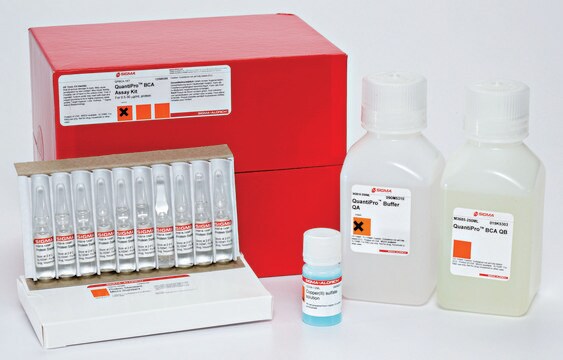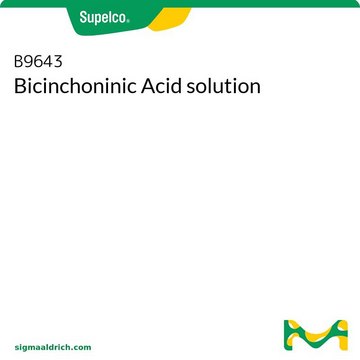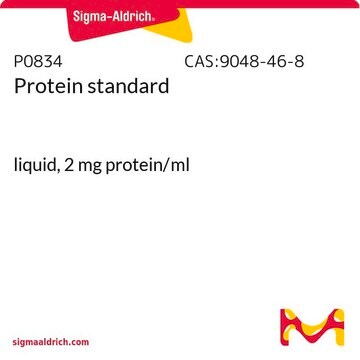71285-M
BCA Protein Assay Kit
The BCA protein assay is a simple and reliable protein quantification method.
Sinónimos:
BCA Protein Quantification, Bicinchoninic Acid Assay, Protein Assay
Iniciar sesiónpara Ver la Fijación de precios por contrato y de la organización
About This Item
UNSPSC Code:
41106500
NACRES:
NA.84
Productos recomendados
manufacturer/tradename
Novagen®
storage condition
OK to freeze
storage temp.
10-30°C
General description
The BCA protein assay is a simple and reliable protein quantification method.
The BCA protein assay is based on a biuretreaction, which is the reduction of Cu2+ toCu+ by proteins in an alkaline solution withconcentration-dependent detection of themonovalent copper ions. Bicinchoninic acidis a chromogenic reagent that chelates thereduced copper, producing a purple complexwith strong absorbance at 562 nm (Smith1985, Wiechelman 1988). This assay can beused to quantify protein concentration with awide variety of samples and can be performedin minutes.
The Novagen® BCA Protein Assay Kit canbe used to determine protein concentrationin the range of 20-2000 µg/ml in either astandard assay or microassay configuration.Kit components are sufficient to complete500 standard-size reactions (50 µl proteinsample plus 1 ml reagent) or 2500 micro-scalereactions (25 µl protein sample plus 200 µlreagent). A BSA standard (2 mg/ml) is providedfor convenient and reliable preparation ofstandard curves.
This assay is robust and can be performedin the presence of many compounds. Somereagents, including chelating agents, strongacids or bases, and reducing agents, interferewith the reduction and chelating reactions onwhich this assay depends (Brown 1989). TheBCA assay is compatible with the followingNovagen protein extraction and lysis reagents:BugBuster Protein Extraction Reagent,PopCulture Reagent, CytoBuster ProteinExtraction Reagent, Reportasol ExtractionBuffer, and Insect PopCulture Reagent. Optionsfor the removal or dilution of interferingsubstances are described in the kit literature.
The Novagen® BCA Protein Assay Kit canbe used to determine protein concentrationin the range of 20-2000 µg/ml in either astandard assay or microassay configuration.Kit components are sufficient to complete500 standard-size reactions (50 µl proteinsample plus 1 ml reagent) or 2500 micro-scalereactions (25 µl protein sample plus 200 µlreagent). A BSA standard (2 mg/ml) is providedfor convenient and reliable preparation ofstandard curves.
This assay is robust and can be performedin the presence of many compounds. Somereagents, including chelating agents, strongacids or bases, and reducing agents, interferewith the reduction and chelating reactions onwhich this assay depends (Brown 1989). TheBCA assay is compatible with the followingNovagen protein extraction and lysis reagents:BugBuster Protein Extraction Reagent,PopCulture Reagent, CytoBuster ProteinExtraction Reagent, Reportasol ExtractionBuffer, and Insect PopCulture Reagent. Optionsfor the removal or dilution of interferingsubstances are described in the kit literature.
Components
•500 mlBCA Solution
•15 ml4% Cupric Sulfate
•3 x 1 mlBSA Standard, 2 mg/ml
•15 ml4% Cupric Sulfate
•3 x 1 mlBSA Standard, 2 mg/ml
Warning
Toxicity: Multiple Toxicity Values, refer to MSDS (O)
Other Notes
Smith, P.K., et al. 1985. Anal. Biochem.150, 76.
Kessler, R. J. and Fanestil, D. D. 1986. Anal. Biochem 159, 138.
Wiechelman, K., et al. 1988. Anal. Biochem.175, 231.
Brown, R., et al. 1989. Anal. Biochem.180, 136.
Kessler, R. J. and Fanestil, D. D. 1986. Anal. Biochem 159, 138.
Wiechelman, K., et al. 1988. Anal. Biochem.175, 231.
Brown, R., et al. 1989. Anal. Biochem.180, 136.
Legal Information
Use of the BCA protein assay is permitted for research purposes only.
NOVAGEN is a registered trademark of Merck KGaA, Darmstadt, Germany
signalword
Danger
hcodes
Hazard Classifications
Aquatic Acute 1 - Aquatic Chronic 1 - Eye Dam. 1
Storage Class
10 - Combustible liquids
Certificados de análisis (COA)
Busque Certificados de análisis (COA) introduciendo el número de lote del producto. Los números de lote se encuentran en la etiqueta del producto después de las palabras «Lot» o «Batch»
¿Ya tiene este producto?
Encuentre la documentación para los productos que ha comprado recientemente en la Biblioteca de documentos.
Shuhan Liu et al.
Oxidative medicine and cellular longevity, 2021, 7674565-7674565 (2021-12-18)
Cysteine metabolism plays a critical role in cancer cell survival. Cysteine depletion was reported to inhibit tumor growth and induce pancreatic cancer cell ferroptosis. Nevertheless, the effect of cysteine depletion in chronic myeloid leukemia (CML) remains to be explored. In
Roberta Gonnella et al.
Microbes and infection, 22(10), 585-591 (2020-09-04)
Viral egress and autophagy are two mechanisms that seem to be strictly connected in Herpesviruses's biology. Several data suggest that the autophagic machinery facilitates the egress of viral capsids and thus the production of new infectious particles. In the Herpesvirus
Abdullah S Shatoor et al.
Saudi journal of biological sciences, 28(12), 7012-7021 (2021-12-07)
This study evaluated the protective effect of astaxanthin (ASX) against high-fat diet (HFD)-induced cardiac damage and fibrosis in rats and examined if the mechanism of protection involves modulating SIRT1. Rat were divided into 5 groups (n = 10/group) as: 1) control: fed
Ranjithmenon Muraleedharan et al.
Cell reports, 32(9), 108092-108092 (2020-09-03)
Lactate is used as an energy source by producer cells or shuttled to neighboring cells and tissues. Both glucose and lactate fulfill the bioenergetic demand of neurons, the latter imported from astrocytes. The contribution of astrocytic lactate to neuronal bioenergetics
Nuestro equipo de científicos tiene experiencia en todas las áreas de investigación: Ciencias de la vida, Ciencia de los materiales, Síntesis química, Cromatografía, Analítica y muchas otras.
Póngase en contacto con el Servicio técnico










